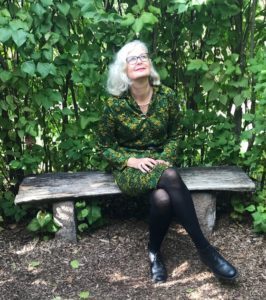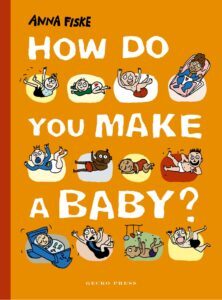 Anna Fiske is an illustrator, author and cartoonist who lives in Norway. She has received numerous awards and been published around the world.
Anna Fiske is an illustrator, author and cartoonist who lives in Norway. She has received numerous awards and been published around the world.
How Do You Make a Baby? is a funny, forthright non-fiction picturebook book about how babies are made and different ways to be a family.
How did you come to illustration as a career?
I like to think of first reading experiences as like topsoil, where all the other books grow from. I had difficulty learning to read as a child, so I would read through the pictures. My memories of illustrations from those books are the earth for new books to grow in.
I have never stopped drawing or thinking about stories since I was a child. Drawing is the first language that you get down on a paper. It’s a powerful tool to help children understand and explain the world and their life.
When I was young, I thought that if I wanted to continue to understand and explain the world by drawing, painting, sculpture, writing, photography, I needed to be an artist. I went to art school. It took a couple of years for me to find out that I could combine all of these interests and be an author and illustrator creating books. I just loved it!
I have created picture books for children ever since. I have challenged myself with different kinds of stories and ways to tell them. I have made cartoons, books with thousands of pictures, books with just a few, an illustrated novel, illustrated poems. I’ve made books about feelings, the body, imagination, friends, people around Earth in one day, travelling and being afraid, being safe, family. I create books about things I want to find out, questions about myself and sometimes questions I get from children that make me think. Children are experts at questioning things; they inspire me.
For gathering ideas, I often also do “creative gym”—things like DIY, painting and ceramics, just for the joy of it and to keep my imagination sharp. The ideas for my books can take many years. An idea will stay in the back of my head while I work with other books, so they’re all there together, like a family.
How did you create the illustrations for this book?
I always draw by hand. Contact with the paper is important to me. First I sketch with a mechanical pencil, then I draw over the sketch using a lightbox—that way I retain the life in the sketch. I have fallen in love with using LAMY fountain pens. These pens are good for a fast line and have a lively curve in the line when you draw. After drawing, I scan and colour the image in Illustrator. I also always handwrite the text. It brings me even closer to the words when I write them by hand.
 Did you have a book like How Do You Make a Baby? as a child?
Did you have a book like How Do You Make a Baby? as a child?
I grew up in Sweden, and I remember seeing the photographs of Lennart Nilsson, where you could see the developing baby inside the mother. It was very abstract to me. I also remember seeing a TV show with a woman giving birth. She screamed a lot, and I felt so sorry for her! I
couldn’t quite relate to that either. My parents were biology teachers but they never explained anything at home. I really do not remember how I found out, but I have two daughters and I’ve written a book about it, so I must have found out about it some how.
What sort of reactions do you get to this book from adults and from children?
It’s overall positive, and that warms my heart, especially how children ask questions and just take it as it is. It’s so good to see how the drawings work. When I ask how you make a baby, the children often know the answer, but when I show the picture, it’s like they nod and say, “Aha, that’s what happened.” When you draw, you don’t have to explain and maybe complicate it; one drawing can be enough.
Adults have told me that the book brings a lot of other questions like, “Did it take long to make me?” and sad things too: “Why was the baby you had in your stomach never a baby?” It’s beautiful that a book can work like a tool, or like a fireplace: a safe place to sit and look into while reading, asking.
What did you love to draw when you were a child?
I loved to draw things I did not understand, things on TV or things my parents talked about. One of my first drawings, which my mother saved, is from when I was two and a half. It’s called “This is a colleague.” The drawing looks like a big monster. When I got older, I often drew lots of girls and women standing together on top of each other holding brooms and buckets. I think it was the feminist in me waking up. I can still feel the joy that I had as a child drawing. I’m one hundred percent myself when I draw and write—the rest of the time, I try to do my best to be me.

